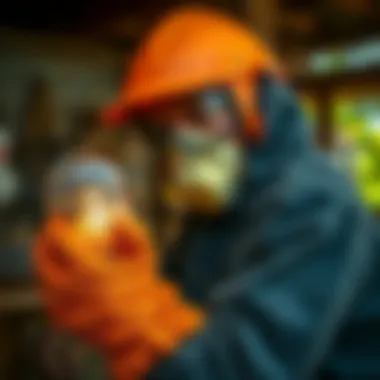Nemesis Pest Control: Effective Solutions for Homeowners


Intro
When it comes to pest control, understanding the enemy is half the battle. Pests like termites and rodents can wreak havoc in homes, often causing significant structural damage and health risks. The ability to identify these intruders, paired with effective prevention and treatment strategies, can save homeowners time and money. This guide aims to equip you with a strategic approach to managing pest problems with a special focus on comprehensive solutions provided by Nemesis Pest Control.
In this article, we will uncover the nature of common pests, dive into prevention tactics that are both practical and sustainable, and explore various treatment options ranging from DIY methods to professional interventions. Whether you are a homeowner seeking to maintain a pest-free environment or someone just looking to learn, understanding these elements is key to effective pest management.
Pest Identification
Pest identification is your first line of defense. By recognizing the signs of infestation early, you can act swiftly before a small problem becomes a major headache.
Detailed Descriptions of Common Pests
- Termites: Often referred to as "silent destroyers," these insects feed on wood and can cause significant damage before the homeowner even realizes it. They have a creamy white body and are usually found in colonies.
- Cockroaches: With their flat bodies and long antennae, cockroaches are indestructible survivors. They thrive in warm, moist environments.
- Rodents: House mice and rats can be more than just annoying; their droppings can pose health risks. Mice are small, usually gray or brown, while rats are larger and have a thicker body.
- Ants: These tiny creatures can invade homes in search of food. Carpenter ants, in particular, can hollow out wood, leading to structural issues.
Signs and Symptoms of Infestations
To effectively combat pests, it is essential to recognize their presence. Here are a few warning signs:
- Termites: Look for mud tubes, discarded wings, or hollow-sounding wood.
- Cockroaches: An unpleasant odor, droppings, and egg cases are indicative of a roach infestation.
- Rodents: Notice gnaw marks, nests made from shredded paper, or visible droppings around food sources.
- Ants: Search for ant trails leading to food sources and small nests in hard-to-reach places.
"The best pest control is prevention, but knowledge is power when it comes to identification."
Prevention Strategies
Now that you know what to look for when it comes to pests, let’s discuss how to keep them at bay.
Home Maintenance Tips for Pest Prevention
Basic home maintenance can deter pests from making your home a sanctuary:
- Seal entry points: Cracks in walls, gaps around windows or doors, and holes in the foundation can all serve as entry points for pests. Ensure everything is sealed.
- Optimize waste disposal: Keep garbage securely covered and clean up any spilled food promptly.
- Trim vegetation: Keep bushes and trees trimmed, as overgrowth can harbor pests closer to your home.
Natural Deterrents and Barriers
You can use natural ingredients to create barriers against pests:
- Peppermint oil: Acts as a strong deterrent for pests such as mice and ants. Mix with water and spray entry points.
- Diatomaceous earth: A powder made from fossilized algae that dehydrates insects. Sprinkle it in areas where pests frequently travel.
Treatment Options
If prevention doesn't do the trick, various treatments can help manage an existing infestation.
Overview of Chemical vs. Natural Treatments
Both types of treatments have their pros and cons. Chemical solutions tend to offer immediate results, but they may also carry risks. On the other hand, natural treatments are generally safer for the environment but may require more time to see effective results.
Step-by-Step Guides for DIY Treatments
- For Termites: Consider using boric acid. Mix with sugar and water; apply to areas where termites are spotted.
- For Cockroaches: You can create a simple roach bait using boric acid and sugar. Place it in areas where roaches tend to gather.
Through the understanding and application of these treatments, you can not only combat existing infestations, but also take significant strides towards creating a pest-free environment in your home.
Prelims to Nemesis Pest Control
When it comes to maintaining a healthy home environment, understanding Nemesis Pest Control becomes essential. The concept encapsulates strategic approaches to tackling pest issues that, if left unresolved, can wreak havoc on your property and peace of mind. Homeowners aren't just looking for quick fixes; they need sustainable, long-term solutions.
Understanding the Concept of Nemesis in Pest Control
The term "Nemesis" evokes a sense of retribution and balance. Within the realm of pest control, it signifies a calculated response to the relentless threats posed by various pests. At its core, Nemesis Pest Control is about outsmarting pests rather than merely exterminating them. The idea is to engage in a clever interplay—understanding the behavior of pests to anticipate their moves, much like a game of chess. Each step, whether it’s identifying a potential problem or implementing preventive measures, acts as a strategic counteraction.
The primary objective is to restore balance within your living environment. For instance, a homeowner might liken their pest problem to a simple itch; it’s not just about scratching it but understanding what caused it in the first place. It draws parallels from various disciplines—nature, tactics, and even psychology—to enable effective pest management.
Importance of Strategic Pest Management
Pest control is not simply an isolated task; it forms an integral part of maintaining a healthy home. Strategic Pest Management (SPM) refers to a systematic approach to identifying, preventing, and addressing pest-related issues.
- Efficiency: By approaching pest control strategically, you save both time and resources. Whether you're dealing with termites or a swarm of ants, an organized strategy eliminates unnecessary repetition and prevents future infestations.
- Sustainability: Rather than relying solely on chemical solutions, Strategic Pest Management emphasizes eco-friendly practices. This is particularly appealing to homeowners who are becoming increasingly conscious of their environmental footprint. Implementing natural deterrents alongside preventative measures is a step toward more sustainable living.
- Long-Term Solutions: Immediate solutions can often lead to a temporary lull. However, with a robust SPM plan, homeowners can achieve lasting results that deter pests from returning.
"A pest problem today can spiral into a crisis tomorrow if not handled with care and strategy."
For further details on effective pest management strategies, consider visiting entomology.wsu.edu or cdc.gov for comprehensive insights into pest behavior and control methods.
Identifying Common Pests
Identifying common pests is essential in the realm of pest control. Recognizing which unwelcome guests have invaded your space sets the stage for figuring out how to deal with them effectively. Knowing their traits helps create targeted strategies for treatment, ensuring your methods are both efficient and eco-friendly. Understanding the common pests in your area not only aids in preventing infestations but also equips you with the know-how to act swiftly should any problems arise.
Types of Pests Targeted
Termites
Termites can play a silent but devastating role in property damage. These pests are most known for their appetite for wood, leading to structural issues over time. Their fascination with cellulose means they can munch through lumber, paper, and even certain plants. A key characteristic of termites is their ability to form colonies, which can number in the thousands. This collective behavior facilitates rapid reproduction and persistent foraging, making them a prominent target for pest control measures.
The unique feature of termites is their tunneling system, which can often be found hidden behind walls or beneath floors, hidden from view. This attribute poses a challenge as their presence is frequently discovered only after significant damage has occurred. Their systematic and damaging behavior makes addressing termite infestations in a timely fashion crucial for home and property protection.
Ants
Ants are ubiquitous social insects, and their presence can signify a range of issues within a household. A notable characteristic is their organization, which allows them to work collectively to find and store food. Ants are often drawn into homes by easily available food sources, and their foraging behavior can lead to large populations if not managed.


A unique aspect of ants is their pheromone communication, which can be a double-edged sword in dealing with them. While this characteristic allows them to efficiently locate food sources, it also means that disturbing their trail can trigger mass migrations of more ants. Their ability to quickly exploit the most minor cracks or gaps makes addressing an ant problem all the more pressing and requires strategized intervention.
Rodents
Rodents, including mice and rats, are notorious for causing havoc in homes. They are adaptable creatures, capable of thriving in numerous environments, including cramped spaces in urban settings. The key characteristic of rodents is their continuously growing incisors, which compel them to gnaw on various materials. Their relentless chewing can lead to severe structural damage and electrical hazards within homes.
Rodents not only cause physical damage, but they also serve as transmitters of diseases, creating substantial health risks. Their tendency to reproduce quickly results in rapid population growth, meaning that early detection is key to preventing an expansive infestation. Their agility and biting habits make rodent control a necessity for maintaining safety and hygiene in residential spaces.
Bed Bugs
Bed bugs are small, elusive pests that thrive on the blood of their hosts, often causing significant distress and health issues. Their signature characteristic is their ability to hide in minuscule crevices, making them a challenge to spot until it’s too late. Bed bugs can reproduce quickly, and their bites can lead to allergic reactions in some individuals, adding to the urgency of detection.
The unique aspect of bed bugs is their nighttime feeding habits. They are adept at hiding during the day, which maintains their populations intact even in heavily trafficked areas. Their resilience to various environmental conditions and treatments demonstrates the importance of recognizing signs of infestation promptly, ensuring that your living space remains a sanctuary and not a battleground against these pests.
Recognizing Signs of Infestation
Once you know what pests to look out for, it’s equally important to recognize the signs they leave behind. These indications not only confirm their presence but also inform the urgency of your response. Spotting these early can save you from costly damage or health concerns down the road.
Visual Indicators
Visual indicators are often the most immediate evidence of a pest problem. This may include physical sightings of the pests themselves or evidence such as droppings, nests, or damaged materials. Such signs are vital because they help to identify the specific type of pest that may be involved. Consequently, this facilitates the creation of an appropriate treatment technique.
A unique feature of visual indicators is that they can often lead to more straightforward identification. For instance, distinct droppings may give away the type of pest, facilitating quicker action. Ignoring these signs can lead to increased population and damage, making vigilant observation essential in any pest prevention strategy.
Noises and Smells
Anyone who's dealt with a pest problem knows that strange noises or smells are often telltale signs of an infestation. Rattling from the walls or scratching sounds in the night can lead you to determine if rodents have made your space their own. Ants, on the other hand, often emit pheromonal scents that are quite unique.
The significance of these sounds and smells lies in their ability to prompt immediate checks on potential hotspots. The unique feature here is that they may alert you even before visual signs are detectable, providing a lead time to act. Ignoring these auditory and olfactory clues might result in a larger infestation than one first suspects.
Structural Damage
Structural damage can be one of the most alarming signs of a pest infestation. Whether it's small holes in the walls, chew marks on wood, or even sagging ceilings, these damages signal that unwelcome visitors are making themselves comfortable. The key characteristic of structural damage is that it often indicates not just activity, but considerable and sometimes costly destruction.
A unique aspect of structural damage is that it serves as both an indication of a pest problem and an urgent call to action to rectify it. The longer one waits to address these issues, the more expensive repairs may become. Therefore, recognizing and responding to structural damage is not only about pest control but also about preserving your property's integrity.
Preventive Measures
Preventive measures serve a crucial role in pest control, offering a proactive approach to keeping unwanted critters at bay. By implementing these strategies, homeowners can prevent infestations before they begin, saving both time and money in the long run. This section dives into effective preventive tactics that are both practical and achievable for any household.
Creating a Pest-Resistant Environment
Creating an environment that resists pests starts with simple, yet effective changes around your home. While pests can be sneaky, making your home less hospitable to them can have a lasting impact.
Eliminating Food Sources
One key element is "Eliminating Food Sources." Pests are attracted to food, whether it's crumbs on the floor, pet dishes left out overnight, or leftovers in open containers. When food is readily available, insects and rodents will flock to it like sailors to a ship.
This strategy is a beneficial choice because it directly cuts off a primary resource pests need to thrive. By keeping food sealed and regularly cleaning up spills, the likelihood of attracting unwelcome guests diminishes significantly.
"Out of sight, out of mind" is especially true when it comes to pests; if they can’t find food, they’ll look for greener pastures.
This tactic's unique feature lies in its simplicity and ease of implementation. However, one must remain diligent, as even minor oversights, like an unattended bowl of fruit, can lead to pest issues. Overall, this often overlooked tactic is a fundamental aspect of effective pest management.
Sealing Entry Points
Next up is "Sealing Entry Points." Pests often enter homes through small cracks and crevices that we barely notice. Sealing these points is essential for blocking potential entryways for ants, mice, and other intruders. It’s a popular tactic in pest prevention and for good reason. When insects can’t find a way into your home, they’re less likely to cause trouble.
The unique feature of this method lies in its long-term durability. Properly sealing entry points can keep pests out for a long while, which ultimately reduces the need for more aggressive pest control measures later on. On the downside, it may require some time and careful inspection to identify every nook and cranny that needs attention.
Maintaining Cleanliness
Last but not least, maintaining cleanliness plays a critical role in preventing pest infestations. A tidy home not only looks appealing but also helps keep pests at bay. Uncluttered spaces facilitate regular cleaning, making it harder for pests to find hiding spots and food.
This practice is highly effective and beneficial since it promotes a healthy living environment, not just for humans, but also for pets. A unique aspect of cleanliness is that it often goes hand-in-hand with other maintenance efforts, creating a well-rounded approach to pest control. However, inconsistency in keeping things clean can create vulnerabilities that pests can exploit.
Regular Inspections and Maintenance
Regular inspections and maintenance are an essential part of your pest prevention strategy. By routinely checking your home for early signs of pest activity—like droppings, nests, or chewed items—you can catch issues before they blow up into full-blown infestations. It is wise to add this habit to your checklist, ensuring that a meticulous eye is kept on potential threats.
Implementing these simple preventive measures will significantly enhance your ability to control pests effectively. Prevention is not just about reaction; it’s about safeguarding your home for the long haul, ensuring that little critters don’t stand a chance.
Natural Pest Control Methods
Natural pest control methods play a vital role in modern pest management strategies. More and more homeowners are turning to these environmentally friendly solutions to tackle infestations. Such methods not only minimize the risks associated with chemical pesticides but also promote a harmonious coexistence with nature. Employing organic practices helps maintain the balance of local ecosystems, keeps surrounding wildlife safe, and often brings additional benefits like enhancing the home’s atmosphere and reducing health risks.
Utilizing Organic Solutions
Essential Oils
Essential oils have gained a lot of traction in pest control due to their remarkable ability to repel various pests. The aromatic compounds found in oils like peppermint, tea tree, and lavender are not just refreshing; they can actually deter insects like ants, mosquitoes, and even rodents. What makes essential oils attractive is their natural origin, allowing for safer indoor applications compared to harsh chemicals. However, their efficacy can be influenced by several factors such as concentration and application method, which means trial and error may be necessary to find the most effective combination.
Botanical Insecticides
Botanical insecticides, derived from plant sources, provide another layer of protection against pests. These products, unlike synthetic variants, offer a less aggressive approach to pest management. One notable characteristic is that they often target specific pests rather than indiscriminately killing beneficial insects. For instance, neem oil is a popular botanical that disrupts the life cycle of aphids and spider mites without harming pollinators. While they can be potent, their speed of action may not rival that of chemical solutions, requiring repeated applications for sustained effects.
Natural Deterrents
Natural deterrents like diatomaceous earth or certain types of vinegar have been recognized for their pest-repelling capabilities. Diatomaceous earth works mechanically by damaging the exoskeletons of pests like cockroaches and fleas. It's considered a safe option for homes with pets and children. Vinegar, on the other hand, can obstruct paths for ants when used strategically on entry points. Although they may not always lead to immediate results, their cumulative effects over time can create a more pest-inhospitable environment.


Biological Control Agents
Biological control agents involve the use of living organisms to manage pest populations. This naturally occurring method leverages the predator-prey relationship in nature, often reducing reliance on chemicals.
Predatory Insects
Predatory insects, such as ladybugs and lacewings, are beneficial allies in the fight against common pests like aphids. These insects are drawn to environments populated by pests, creating a natural balance. The key characteristic of using predatory insects is that they eat the pests, effectively reducing their numbers without harming the ecosystem. It's essential to consider their seasonal availability, however, as their influence can be fluctuated based on environmental conditions.
Microbial Products
Microbial products are another innovative avenue in pest control, utilizing microorganisms like bacteria and fungi to combat infestations. Types such as Bacillus thuringiensis (Bt) specifically target caterpillar stages of many pests without affecting non-target species. Their unique feature is their ability to effectively eliminate pests while remaining harmless to wildlife and humans alike. Although microbial agents often require careful timing in application, their long-lasting effects make them a worthwhile investment for those seeking sustainable pest control solutions.
Chemical Treatment Options
Chemical treatment options play a critical role in the world of pest control. When facing infestations, especially with persistent nuisances like termites or rodents, these solutions provide quick and effective avenues for eradication. By understanding the mechanisms, characteristics, and safety measures linked with chemical methods, homeowners can make informed decisions that protect their spaces efficiently.
Overview of Chemical Solutions
Types of Pesticides
When talking about types of pesticides, it’s essential to understand that they are categorized based on their target pests and mode of action. Broadly, pesticides can be classified into several groups such as insecticides, herbicides, and fungicides. Each of these groups is designed to combat specific nuisances. For example, insecticides are aimed at killing bugs, while herbicides target unwanted plants.
A key characteristic of insecticides is their potent effectiveness against common household pests like ants and bed bugs. Each type of pesticide comes with its unique features, and some may have specific formulations meant for indoor use, while others are suited for outdoor environments.
Advantages of using these pesticides include their rapid action and often long-lasting effects. However, one downside is the development of pesticide resistance, which can make certain pests harder to eliminate over time.
Application Techniques
Application techniques are another crucial aspect in the world of chemical treatments. Techniques vary from spray applications to bait systems, each having its own set of advantages depending on the situation at hand.
For instance, spraying is often favored for large infestations due to its broad coverage. It allows for quick distribution of chemicals across an area, ensuring that even those hard-to-reach corners are treated. Alternatively, bait systems target pests more directly, reducing chemical exposure to the environment.
The main characteristic of these techniques is their focus on both effectiveness and coverage. Using the right application method can vastly improve outcomes, ensuring minimal wastage of pesticides.
In contrast, some techniques may come with challenges — for example, incorrect application can lead to inadequate coverage or the necessity for repeat applications, potentially increasing costs.
Safety Considerations
Safety is paramount when dealing with chemical pest control methods. Ensuring proper precautions go beyond just protecting the pest control operator; it extends to everyone around the treated area — including pets and young children.
Personal Protective Equipment
When it comes to personal protective equipment (PPE), it is indispensable. PPE helps safeguard individuals from exposure to harmful chemicals while they apply pesticides. Items such as gloves, masks, goggles, and protective suits are commonly recommended.
The key characteristic here is that PPE serves as a barrier between the chemical substances and the user’s skin and respiratory system, reducing the risk of health issues. It is crucial for operators to wear appropriate gear, as neglecting this can lead to severe health implications or accidents.
On the flip side, the imposition of wearing PPE can sometimes make pest control tasks cumbersome, particularly for DIY homeowners who may not be as familiar with handling chemicals.
Environmental Impact
The environmental impact of chemical treatments cannot be overlooked. While these products often provide fast solutions, they can also pose risks to local ecosystems if not used properly. Pesticides can contaminate soils and waterways, affecting not just pests, but also beneficial insects and plants.
An important characteristic of environmentally-conscious pest control is assessing how chemical applications affect the surrounding habitat. Homeowners are encouraged to consider alternatives or integrated approaches that minimize chemical use or focus on targeted application.
The benefit of understanding the environmental impact is to foster responsible usage, reducing long-term adverse effects. However, with the urgent need to control pests appearing, some might overlook these considerations if not well educated or reminded of them.
"Safeguarding our health and environment is as vital as combatting pests. Wearing protective gear and being cognizant of chemical effects on nature creates a balanced approach to pest control."
Ultimately, when implementing chemical treatment options, a thoughtful approach combining efficacy with safety and environmental considerations will yield the best results in pest management. Homeowners should stay informed and be proactive in employing best practices, ensuring their strategies do not compromise their safety or their surroundings.
Integrated Pest Management Strategies
Integrated Pest Management (IPM) strategies serve as the backbone for effective pest control methods. In an era where the misuse of chemicals and environmental concerns are at the forefront, implementing IPM offers a sustainable approach that doesn't just tackle pests but aims to prevent them long-term. This section will delve into the fundamentals of IPM, highlighting its significance and its role in minimizing pest issues while safeguarding our environment. The multifaceted benefits of integrated strategies can lead to reduced reliance on chemicals and more thoughtful management practices, ultimately protecting both homes and health.
Understanding Integrated Pest Management (IPM)
When speaking of pest control, the term Integrated Pest Management encompasses a variety of strategies designed to manage pest populations economically and sustainably. It aims not merely to eliminate pests but to suppress their populations to levels that do not cause significant economic damage or health risks.
Understanding IPM involves recognizing its core components:
- Prevention: The first step involves identifying and managing conditions that contribute to pest infestations.
- Monitoring: Regular monitoring of pest populations to determine when action is needed is crucial to manage outbreaks effectively.
- Control Methods: These are a mix of biological, cultural, physical, and chemical control strategies that are employed based on specific needs.
Adopting an IPM approach is beneficial because it balances efficacy and safety, allowing homeowners to enjoy their living spaces without undue concern over over-reliance on chemicals.
Developing a Comprehensive IPM Plan
Creating a sound IPM plan is paramount to effectively managing pest problems. Such a plan should be dynamic, adjusting to the unique challenges each situation presents. It needs to incorporate a two-fold effort—assessing pest problems and consistently monitoring them. This ensures that control measures are timely and responsive.
Assessment of Pest Problems
A thorough assessment of pest problems is a crucial first step in developing any IPM strategy. This involves not only identifying the type of pests present but also understanding their life cycles and behaviors. A well-conducted assessment can reveal significant insights such as how pests infiltrate properties and which environmental factors foster their growth.
Key characteristics of assessing pest issues include:
- Integration with Environmental Factors: Recognizing linkages between pest behaviors and environmental conditions can often shed light on the causes of infestations.
- Benefit of Early Detection: Catching a problem early often mitigates potential damages and reduces the escalation of control measures that may be necessary later on.
Moreover, the unique aspect of this assessment lies in its adaptability—based on findings, it can be refined over time. This iterative approach can lead to informed decision-making, enabling homeowners to take effective preventative steps.


Monitoring and Evaluation
Monitoring and evaluation are the heartbeat of a successful IPM strategy. This continuous process allows for the detection of pest activity and the effectiveness of mechanisms in place. Just like a watchful eye, it helps in fine-tuning the approach to pest management.
The significance of monitoring rests on these aspects:
- Real-time Data Gathering: Collecting data on pest activity can inform management decisions and deter ineffective interventions.
- Timeliness of Response: Vigilance in monitoring enables homeowners to respond swiftly to potential outbreaks, thus preventing widespread infestations.
A unique feature about monitoring is the use of technology—smart traps and automated systems can send alerts when pests are detected, offering an unprecedented level of oversight. However, while these methods provide notable advantages, they can also present challenges, such as the need for higher initial investments and proper understanding of the technology.
In sum, implementing IPM strategies is pivotal for effective pest control. Whether you're a seasoned pest management professional or simply a homeowner aiming to protect your space, integrating these practices can foster a responsible and sustainable approach to pest management.
"An ounce of prevention is worth a pound of cure." - Benjamin Franklin
By keeping an eye on pest conditions and adapting as needed, pest issues can be handled with less stress and better effectiveness.
Innovative Technologies in Pest Control
Innovative technologies are reshaping the landscape of pest control, enabling not just better methods, but truly transformative solutions. The conventional wisdom of pest management is evolving as these technologies provide more effective and efficient ways to tackle infestations. By employing advanced tools and techniques, pest control professionals and homeowners alike can enhance their strategies for keeping nuisances at bay.
Advancements in Pest Control Technology
Smart Traps
Smart traps represent a significant leap forward in pest control. These devices utilize sensors and connectivity features to detect a range of pests efficiently. The allure of smart traps lies in their ability to save both time and resources. For instance, when a rodent enters a trap, the system sends an alert directly to a smartphone or computer, allowing for timely action. One notable characteristic of smart traps is their precision; they often employ bait that precisely targets specific pests while minimizing interference with non-target species.
However, it's worth noting that the initial investment can be steep. Still, the long-term savings from reduced pest populations make them an efficient choice for proactive pest management. Moreover, monitoring happens in real time, which can be crucial for areas prone to severe infestations.
Automated Monitoring Systems
Automated monitoring systems are another feather in the cap of modern pest control. These sophisticated setups employ web-connected sensors that provide constant updates about pest activity. This continuous monitoring allows for early detection, which is vital. Such systems can track environmental changes, temperature fluctuations, and even pest movements.
The most striking aspect of these systems is their ability to reduce human intervention. Households and businesses can opt for management solutions that run in the background without constant attention. Though some users may find the need for Wi-Fi or smart devices a hurdle, the benefits of real-time data tracking significantly outweigh these issues. You'll be able to sit back and relax, confident that your pest issues are under careful surveillance.
Data Analytics
Delving into data analytics provides a keen edge in pest control strategies. By analyzing historical infestation data, patterns and trends can be identified. This approach suggests not only the best timing for interventions but also highlights what specific methods to use against various pests.
The key characteristic of data analytics is its capacity to turn raw information into actionable insights. For instance, if a survey shows that pests surge during particular months or under certain conditions, tailor-made strategies can be developed. This proactive strategy shifts the focus from reactive, after-the-fact responses to preemptive actions.
However, while data analytics offers profound benefits, reliance on technology can create a dependency. In addition, not every homeowner may feel comfortable navigating or understanding complex data output. Hence, training or professional assistance becomes somewhat indispensable for effective utilization.
"In pest control, knowledge is power; innovative technologies turn that knowledge into practical strategies."
Future of Pest Control Solutions
As we look toward the future, pest control solutions are poised to advance even further. Integrating artificial intelligence with pest management is an exciting frontier that holds promise for personalized and anticipatory treatments. Expect to see an increase in systems using machine learning to analyze pest behavior and adapt solutions accordingly.
Moreover, with a growing emphasis on sustainability, the blending of innovative technology and eco-friendly practices is likely to become the norm. Innovations such as biodegradable pest deterrents and eco-friendly monitoring systems will play a key role in effective yet responsible pest management.
In summary, embracing innovative technologies in pest control can yield significant benefits for both individuals and professionals. These tools enable more targeted, efficient, and environmentally friendly pest management solutions.
Stay informed, stay ahead.
The Role of Education in Pest Control
Education holds a pivotal role in the realm of pest control, much like a sturdy foundation supports a house. Understanding pest behavior and effective intervention techniques enables both professionals and homeowners to tackle infestations proactively rather than reactively. Without a strong base of knowledge, efforts can easily fall flat, costing time, money, and peace of mind.
Equipping pest control professionals with proper training ensures that they grasp the complexities of various pest species, their life cycles, and the ecosystems in which they thrive. More importantly, it fosters a mindset focused on sustainable practices that align with modern environmental standards. Education is particularly vital in this industry, where misinformation can lead to ineffective solutions or even hazardous situations.
For homeowners, knowledge is power. Being informed about pests enables proactive measures that not only prevent infestations but also protect the integrity of one’s home. Understanding the signs of a pest problem and knowing when to call a professional can save the hassle of more severe infestations, which can escalate quickly left unattended.
"An ounce of prevention is worth a pound of cure." – Benjamin Franklin
In the context of pest control, this adage is particularly relevant. With the right information, homeowners can adopt preventative practices that protect their living spaces while pest control professionals can stay ahead of the game, offering timely and effective solutions.
Training for Pest Control Professionals
Effective training programs for pest control professionals are essential. These courses cover a range of topics:
- Pest Identification: Knowing the various types of pests, such as termites, rodents, and ants, helps in crafting targeted treatment strategies.
- Safe Chemical Handling: Understanding the appropriate use of pesticides, including dosage and application techniques, ensures safety for both the user and the environment.
- Sustainability Practices: Today's professionals must learn about eco-friendly pest control methods. Emphasizing biological control and the integration of organic products into pest management reflects a shift towards more sustainable approaches.
Moreover, ongoing education is critical as technologies and methodologies evolve. Workshops, seminars, and certifications allow professionals to stay current with the latest developments in pest management techniques, ensuring best practices are being implemented in the field.
Educating Homeowners
Homeowners play a crucial role in effective pest management too. Here are several key areas where education makes a significant difference:
- Recognizing Early Signs: Homeowners should learn to spot early indicators of infestations, such as droppings or gnaw marks, enabling early intervention.
- Understanding Prevention: Simple strategies like maintaining a clean environment, sealing food sources, and closing entry points can deter pests before they become a problem.
- When to Seek Help: Knowing when to call in a pest control professional can save homeowners from the stress of large-scale infestations. A clear understanding of pest behavior will guide homeowners in making timely decisions.
Sharing resources and information can empower homeowners. Useful websites like EPA - Pest Control provide guidelines on pest prevention and eco-friendly solutions. Educational community workshops organized by local governments or pest control businesses also offer insights and interactive learning experiences tailored to residential needs.
Finale and Recommendations
In wrapping up this deep dive into pest control strategies, it’s clear that managing pests through the Nemesis approach is both an art and a science. This method emphasizes a balanced strategy, incorporating various methods of identification, prevention, and treatment. Homeowners face pests not just as nuisances but as potential threats to their homes and health. Understanding how to effectively combat these invaders can save time, money, and a whole lot of frustration.
A major takeaway from this guide is the importance of proactive management. Relying solely on reactive measures when a pest problem arises is akin to locking the barn door after the horse has bolted. Implementing preventive measures—such as sealing entry points and maintaining cleanliness—should always come first. Additionally, regular inspections form the backbone of effective pest management as they enable early detection.
Here are some key recommendations to consider:
- Stay Informed: Knowledge is power. Enroll in pest management training or workshops relevant for homeowners. Understanding pest behavior enables more effective strategies.
- Consider Natural Solutions First: Whenever possible, opt for organic pest control methods. Solutions like essential oils and natural deterrents can be effective and less harmful to yourself, your family, and the environment.
- Do Not Overlook Chemical Treatments: While natural methods are appealing, they may not always suffice. Be prepared with chemical solutions where necessary, but always follow safety protocols and environmental guidelines.
- Monitor and Evaluate: After implementing any pest control measures, it’s essential to monitor the situation. Keeping a log of any sightings, treatments, and results can help refine your strategy over time.
To underscore the significance of these measures, consider the words from the National Pest Management Association:
"Taking time to understand pests can lead to smarter, more effective management strategies."



